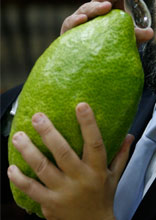In I got It!
An Exceptional Esrog
The biggest ever esrog in the world was grown in Netanya in Eretz Yisrael – it weighed over four kilograms
This esrog was a Yemenite esrog, and was grown in the private garden of a resident of Kiryat Sanz in Netanya. It weighed precisely 4.4 kilograms, and it measured 30cm in length, 20cm in width and had a circumference of 62cm. It was discovered shortly before the festival of Sukkos in the year 5766.
However, in the book of the Guinness World of Records, it states that the biggest esrog in the world was another, smaller one, which measured just 37cm in length, 17cm in width, and weighed only approximately 4 kg. This other esrog grew in the year 5766, the same year as the esrog from Netanya, in the nature reserve of Neot Kedumim which is near the Ben Shemen forest. Compared to this massive fruit, the other esrogim growing nearby looked like little oranges. The esrog from Neot Kedumim itself broke a previous record for the largest esrog, which was also set by an esrog from Neot Kedumim some five years previously, in the year 5761. That esrog had weighed 3.66 kg.
In the period of the Mishnah, the largest esrog known of was one owned by Rabbi Akiva. It was so huge that it was carried on the back, in the manner in which one would transport an extremely heavy object – such is recorded in the Babylonian Talmud, maseches Sukkah, daf 36; “Rabi Yosi said – Rabbi Akiva came to the house of prayer with his esrog on his back…” The Gemora mentions this as part of its discussion as to whether an excessively-large esrog is considered a hiddur of the mitzvah of the four species.
Today it is estimated that Rabbi Akiva’s esrog must have weighed in the region of seven kilograms, a size which is impossible to replicate.
As a rule, the esrogim that weigh the most are Yemenite esrogim, which are generally accepted as not having been grafted together with lemons, a practice which itself limits the growth of the fruit.







